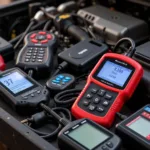Finding the right auto diagnostic tool can feel like navigating a maze. With countless options flooding the market, each promising to be the ultimate solution, how do you choose the best fit for your needs? Whether you’re a seasoned mechanic or a car enthusiast, understanding your vehicle’s health is crucial. This guide delves into the world of auto diagnostic tools, equipping you with the knowledge to make an informed decision.
Demystifying Auto Diagnostic Tools: What are they and why do you need one?
An auto diagnostic tool for all cars is essentially a device that acts as a translator between you and your car’s computer system. It retrieves and deciphers Diagnostic Trouble Codes (DTCs) – those cryptic codes that illuminate your dashboard warning lights.
But these tools are much more than just code readers. Depending on the model and its features, they can:
- Read and clear DTCs: Identify the root cause of a warning light.
- Display live data streams: Monitor parameters like engine RPM, coolant temperature, and oxygen sensor readings in real-time.
- Perform actuator tests: Check the functionality of various components like fuel injectors, solenoids, and actuators.
- Reset service reminders: Clear service lights after routine maintenance.
- Access manufacturer-specific systems: Delve deeper into the diagnostics of your vehicle’s specific make and model.
Navigating the Types of Auto Diagnostic Tools
From basic code readers to advanced professional scanners, the market offers a wide spectrum of auto diagnostic tools for all cars. Let’s break down the most common types:
1. Code Readers: Your Pocket-Friendly Diagnostic Companion
 Compact Car Code Reader Handheld
Compact Car Code Reader Handheld
As the name suggests, code readers primarily focus on retrieving and displaying DTCs. They are typically compact, user-friendly, and budget-friendly, making them suitable for car owners who want a quick insight into their vehicle’s health.
2. OBD-II Scanners: Taking Diagnostics a Step Further
OBD-II scanners offer a more comprehensive approach than basic code readers. They not only display DTCs but also provide access to live data streams, allowing you to monitor your car’s performance in real-time. Many models also offer additional features like freeze frame data (a snapshot of the vehicle’s parameters when a fault code was stored) and emissions readiness checks.
3. Professional-Grade Scan Tools: The Mechanic’s Arsenal
Professional-grade scan tools are the heavyweights of the diagnostic world. They offer a vast array of advanced features, including bi-directional control (the ability to command actuators), programming capabilities, and access to manufacturer-specific systems. These tools are indispensable for professional mechanics and experienced DIYers working on complex repairs.
Factors to Consider When Choosing an Auto Diagnostic Tool for All Cars
With a plethora of options available, selecting the right auto diagnostic tool for your needs can be overwhelming. Consider these key factors to guide your decision:
- Your Budget: Prices can range from affordable code readers to expensive professional scanners.
- Your Skill Level: Beginner-friendly tools offer simple interfaces, while advanced scanners require a deeper understanding of vehicle systems.
- Vehicle Compatibility: Ensure the tool is compatible with your car’s make, model, and year, particularly if you require access to manufacturer-specific systems.
- Desired Features: Determine the level of diagnostic depth you need – from basic code reading to advanced bi-directional control and programming.
- User Interface: Opt for a tool with an intuitive and user-friendly interface, particularly if you’re new to car diagnostics.
The Future of Auto Diagnostic Tools: Embracing Technology
The world of auto diagnostics is continuously evolving. As vehicles become increasingly sophisticated, diagnostic tools are keeping pace with innovative features:
- Wireless Connectivity: Bluetooth and Wi-Fi enabled tools allow for seamless data transfer and remote diagnostics.
- Cloud-Based Platforms: Accessing vehicle data, storing diagnostic reports, and collaborating with other technicians is simplified through cloud integration.
- Augmented Reality: Some advanced tools leverage augmented reality to overlay diagnostic information onto a live view of the engine bay, simplifying complex repairs.
Investing in Knowledge: The Key to Effective Diagnostics
While an auto diagnostic tool for all cars is an invaluable asset, it’s essential to remember that it’s just that – a tool. The true power lies in your ability to interpret the data it provides and apply your knowledge to diagnose and repair your vehicle effectively.
Investing in resources like repair manuals, online forums, and training courses can significantly enhance your diagnostic skills, allowing you to get the most out of your investment.
Conclusion: Empowering Car Owners and Mechanics Alike
In an era of increasingly complex vehicles, auto diagnostic tools have become essential for car owners and mechanics alike. By understanding the different types of tools, their features, and your specific needs, you can choose the perfect diagnostic companion to keep your car running smoothly.
Remember, knowledge is power. Equip yourself with the right tools and information, and you’ll be well-equipped to tackle any automotive challenge that comes your way.

